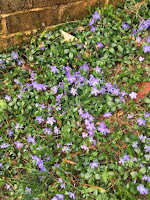Just outside my window
Periwinkle’s evergreen
Periwinkle’s strong,
Under the snow it lives
All Winter long.
When the first thaw come
Periwinkle’s seen
In all its myrtle grace
Clear, dark green.
I know a hill where
Periwinkle grows,
A little hill that
The morning knows.
- Periwinkle, Louise Driscoll (1875-1957)
As noted in Driscoll’s poem, periwinkle is an evergreen ground cover vine. It may be found growing nearly world-wide. Though no one is sure, it’s believed the word, Vinca, is derived from a Latin word meaning "to bind." Vinca is a trailing plant, and the runners root as they extend. The long, tough runners were used in some cultures to form rope.
Mature height as a ground cover is usually from 8" to 18". Flower colors range from blue to white or burgundy, depending upon the cultivar. Vinca prefers moist soil in partial shade to full shade, but will also tolerate sun and drought. It is deer resistant.
There are two species of Vinca commonly available: Vinca major and Vinca minor. Louise Driscoll wrote about V. minor.
Vinca minor is commonly known as dwarf periwinkle, creeping myrtle, or death myrtle. It does contain toxic substances. I’m sure that’s why the name figured in the Harry Potter story with the ghost, Moaning Myrtle.
Vinca foliage is about 3/4" wide and 1" long. Mature height is about 4". Foliage is deep green and shiny. It is hardy in USDA climate zones 4 through 8. Soil pH should range from 6.1 to 7.8.
Find Your USDA Plant Hardiness Zone By Zip Code
 As a ground cover, vinca is effective for erosion control on hillsides. If planting it for erosion control, try to mitigate the water flow until the plants are established, otherwise the water might dislodge them.
As a ground cover, vinca is effective for erosion control on hillsides. If planting it for erosion control, try to mitigate the water flow until the plants are established, otherwise the water might dislodge them.Periwinkle does well in shallow soil, even where tree roots render it difficult to cultivate. But, if possible, prepare the planting bed by cultivating about 4" deep, removing all traces of weeds. Composted manure may be incorporated into the soil. Plant 6" to 12" apart. If fertilizer is used, incorporate 10-10-10 fertilizer at a rate of no more 2 lbs. per 100 square feet into the top 4" of soil. Avoid synthetic fertilizers contacting any part of your plants.
Periwinkle can be planted any time of year, even bare root plants. Even so, you should water occasionally until the plants become established to avoid drought stress. Maintenance is minimal. Periwinkle has few pest and disease problems, and tolerates poor soil.
Because it is so common, folks often overlook it, unless it’s found growing where they don’t want it. As I’ve often said, “it does what a ground cover is supposed to do; it covers ground.” Periwinkle is popular precisely because it is so effective, attractive, and requires practically no maintenance.
Return to Vinca at GoGardenNow.






No comments:
Post a Comment